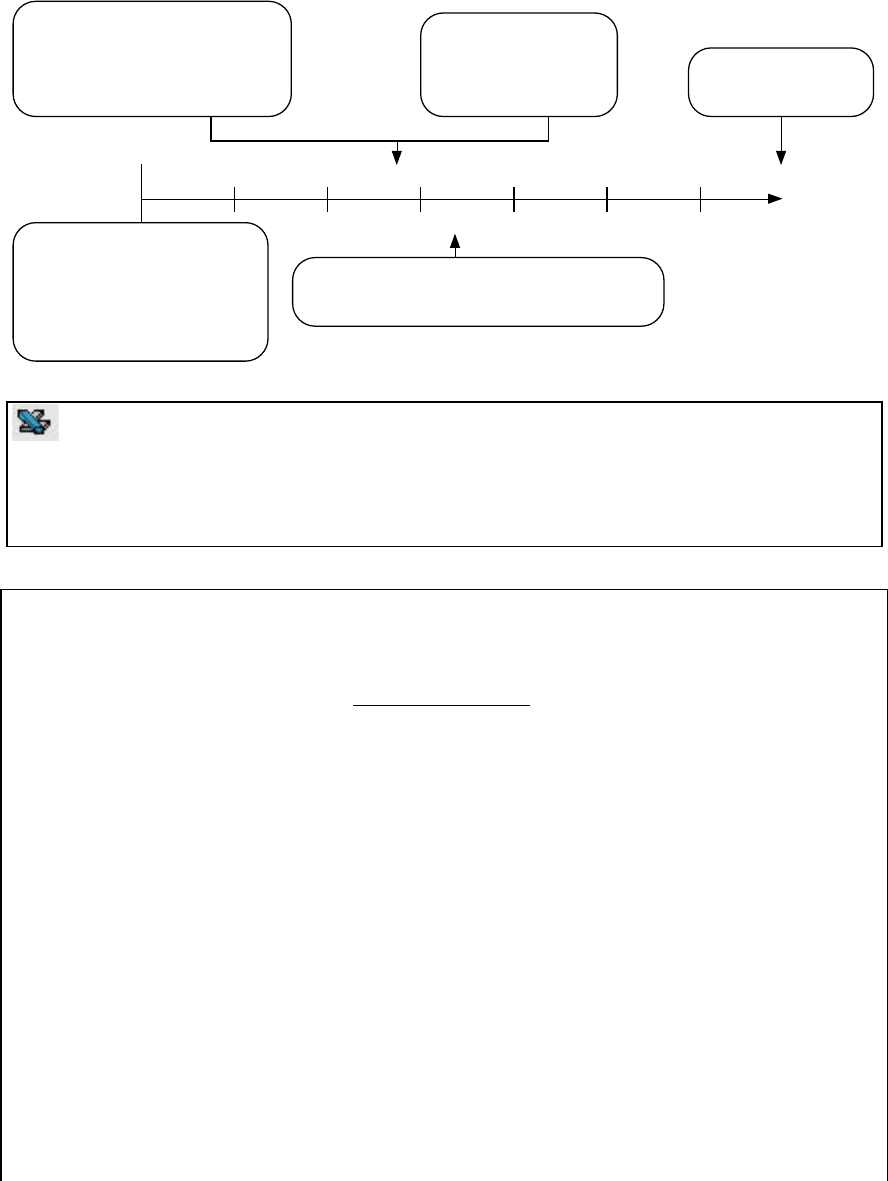Damodaran A. Applied corporate finance
Подождите немного. Документ загружается.

61
61
9. Assume now that you have been asked to forecast cash flows that you will have available to
repurchase stock and pay dividends during the next 5 years for Conrail (from problem 8). In
making these forecasts, you can assume the following –
• Net Income is anticipated to grow 10% a year from 1995 levels for the next 5 years
• Capital expenditures and depreciation are expected to grow 8% a year from 1995 levels
• The revenues in 1995 were $ 3.75 billion, and are expected to grow 5% each year for the next
5 years. The working capital as a percent of revenues is expected to remain at 1995 levels
• The proportion of net capital expenditures and depreciation that will be financed with debt
will drop to 30%
a. Estimate how much cash Conrail will have available to pay dividends or repurchase stocks
over the next 5 years.
b. How will the perceived uncertainty associated with these cash flows affect your decision on
dividends and equity repurchases?
10. Cracker Barrel, which operates restauarants and gift stores, is reexamining its policy of
paying minimal dividends. In 1995, Cracker Barrel reported net income of $ 66 million; it had
capital expenditures of $ 150 million in that year and claimed depreciation of only $ 50 million.
The working capital in 1995 was $ 43 million on sales of $ 783 million. Looking forward,
Cracker Barrel expects the following:
• Net Income is expected to grow 17% a year for the next 5 years
• During the 5 years, capital expenditures are expected to grow 10% a year and depreciation is
expected to grow 15% a year
• The working capital as a percent of revenues is expected to remain at 1995 levels, and
revenues are expected to grow 10% a year during the period
• The company has not used debt to finance its net capital expenditures and does not plan to
use any for the next 5 years
a. Estimate how much cash Cracker Barrel would have available to pay out to its stockholders
over the next 5 years
b. How would your answer change, if the firm plans to increase its leverage by borrowing 25%
of its net capital expenditure and working capital needs?
62
62
11. Assume that Cracker Barrel, from problem 10, wants to continue with its policy of not
paying dividends. You are the CEO of Cracker Barrel and have been confronted by dissident
stockholders, demanding to know why you are not paying out your FCFE (estimated in the
previous problem) to your stockholders. How would you defend your decision? How receptive
will stockholders be to your defense? Would it make any difference that Cracker Barrel has
earned a return on equity of 25% over the previous five years, and that its beta is only 1.2?
12. Manpower Corporation, which provides non-government emplyments services in the United
States, reported net income of $ 128 million in 1995. It had capital expenditures of $ 50 million
and depreciation of $ 24 million in 1995, and its working capital was $ 500 million (on revenues
of $ 5 billion). The firm has a debt ratio of 10%, and plans to maintain this debt ratio.
a. Estimate how much Manpower Corporation will have available to pay out as dividends next
year.
b. The current cash balance is $ 143 million. If Manpower Corporation is expected to pay $ 12
million in dividends next year and repurchase no stock, estimate the expected cash balance at the
end of the next year.
13. How would your answers to the previous problem change if Manpower Corporation in
problem 12 plans to pay off its outstanding debt of $ 100 million next year and become a debt-
free company?
14. You are an institutional investor and have the collected the following information on five
maritime firms in order to assess their dividend policies:
Company FCFE Dividends Paid ROE Beta
Alexander & Brown $ 55 $ 35 8% 0.80
American President $ 60 $ 12 14.5% 1.30
OMI Corporation - $ 15 $ 5 4.0% 1.25
Overseas Shipholding $ 20 $ 12 1.5 % 0.90
Sea Containers - $ 5 $ 8 14% 1.05
The average riskfree rate during the period was 7% and the average return on the market was
12%.
a. Assess which of these firms you would pressure to pay more in dividends.

63
63
b. Which of the firms would you encourage to pay less in dividends?
c. How would you modify this analysis to reflect your expectations about the future of the entire
sector?
15. You are analyzing the dividend policy of Black and Decker, a manufacturer of tools
and appliances. The following table summarizes the dividend payout ratios, yields and
expected growth rates of other firms in the waste disposal business.
Company
Payout Ratio
Dividend Yield
Ex. Growth
Fedders Corporation
11%
1.2%
11.0%
Maytag Corporation
37%
2.8%
23.0%
National Presto
67%
4.9%
13.5%
Toro Corporation
15%
1.5%
16.5%
Whirlpool Corp.
30%
2.5%
20.5%
Black & Decker
24%
1.3%
23.0%
a. Compare Black and Decker’s dividend policy to those of its peers, using the average
dividend payout ratios and yields.
b. Do the same comparison, controlling for differences in expected growth.
16. The following regression was run using all NYSE firms in 1995
YIELD = 0.0478 - 0.0157 BETA + 0.0000008 MKTCAP + 0.6797 DBTRATIO + 0.0002
ROE - 0.09 NCEX/TA R
2
= 12.88%
where BETA = Beta of the stock
MKTCAP = Market Value of Equity + Book Value of Debt
DBTRATIO = Book Value of Debt / MKTCAP
ROE = Return on Equity in 1994
NCEX/TA = (Capital Expenditures - Depreciation) / Total Assets
The corresponding values for Black and Decker, in 1995, were as follows:
Beta = 1.30
MKTCAP = $ 5,500 million
DBTRATIO = 35%
ROE = 14.5%
64
64
NCEX/TA = 4.00%
Black and Decker had a dividend yield of 1.3% and a dividend payout ratio of 24% in
1995.
a. Estimate the dividend yield for Allwaste, based upon the regression.
b. Why might your answer be different, using this approach, than the answer to the prior
question, where you used only the comparable firms?
17. Handy and Harman, a leading fabricator of precious metal alloys, pays out only 23%
of its earnings as dividends. The average dividend payout ratio for metal fabricating firms
is 45%. The average growth rate in earnings for the entire sector is 10% (Handy and
Harman is expected to grow 23%). Should Handy and Harman pay more in dividends just
to get closer to the average payout ratio? Why or why not?

1
1
CHAPTER 12
VALUATION: PRINCIPLES AND PRACTICE
In this chapter, we look at how to value a firm and its equity, given what we now
know about investment, financing and dividend decisions. We will consider two
approaches to valuation. The first and most fundamental approach to valuing a firm is
discounted cash flow valuation, which extends the present value principles that we
developed to analyze projects to value a firm. The value of any firm is determined by
four factors – its capacity to generate cash flows from assets in place, the expected
growth rate of these cash flows, the length of time it will take for the firm to reach stable
growth, and the cost of capital. Consequently, to increase the value of a firm, we have to
change one or more of these variables.
The second way of valuing a firm or its equity is to based the value on how the
market is valuing similar or comparable firms; this approach is called relative valuation.
This approach can yield values that are different from a discounted cashflow valuation
and we will look at some of the reasons why these differences may occur.
In a departure from the previous chapters, we will take the perspective of
investors in financial markets in estimating value. Investors assess the value of a firm’s
stock in order to decide whether to buy the stock or, if they already own it, whether to
continue to it.
Discounted Cash Flow Valuation
In discounted cash flow valuation, we estimate the value of any asset by
discounting the expected cash flows on that asset at a rate that reflects their riskiness. In a
sense, we measure the intrinsic value of an asset. The value of any asset is a function of
the cash flows generated by that asset, the life of the asset, the expected growth in the
cash flows and the riskiness associated with them. In other words, it is the present value
of the expected cash flows on that asset.
!
Value of Asset =
E(Cash Flow
t
)
(1+ r)
t
t =1
t =N
"
where the asset has a life of N years and r is the discount rate that reflects both the
riskiness of the cash flows and financing mix used to acquire the asset. If we view a firm

2
2
as a portfolio of assets, this equation can be extended to value a firm, using cash flows to
the firm over its life and a discount rate that reflects the collective risk of the firm’s
assets.
This process is complicated by the fact that while some of the assets of a firm have
already been created, and thus are assets-in-place, a significant component of firm value
reflects expectations about future investments. Thus, we not only need to measure the
cash flows from current investments, but we also must estimate the expected value from
future investments. In the sections that follow, we will introduce the discounted cash flow
model in steps. We begin by discussing two different ways of approaching valuation –
equity and firm valuation – and then move on to consider how best to estimate the inputs
into valuation models, and then consider how to go from the value of a firm to the value
of equity per share.
Equity Valuation versus Firm Valuation
There are two paths to discounted cash flow valuation -- the first is to value just
the equity stake in the business; the
second is to value the entire firm,
including equity and any other
claimholders in the firm (bondholders,
preferred stockholders, etc.). While both approaches discount expected cash flows, the
relevant cash flows and discount rates are different for each.
The value of equity is obtained by discounting expected cash flows to equity ––
i.e., the residual cash flows after meeting all expenses, tax obligations, and interest and
principal payments –– at the cost of equity –– i.e., the rate of return required by equity
investors in the firm.
Value of Equity =
CF to Equity
t
(1+ k
e
)
t
t =1
t =n
!
where
CF to Equity
t
= Expected Cash flow to Equity in period t
k
e
= Cost of Equity
Value of Equity: This is the value of the equity
stake in a business; in the context of a publicly
traded firm, it is the value of the common stock in
the firm.

3
3
The dividend discount model is a specialized case of equity valuation, where the value of
a stock is the present value of expected future dividends.
The value of the firm is obtained by discounting expected cash flows to the firm,
i.e., residual cash flows after meeting all
operating expenses and taxes, but prior
to debt payments –– at the weighted
average cost of capital –– i.e., the cost
of the different components of financing
used by the firm, weighted by their market value proportions.
Value of Firm =
CF to Firm
t
(1+ WACC)
t
t=1
t=n
!
where
CF to Firm
t
= Expected Cash flow to Firm in period t
WACC = Weighted Average Cost of Capital
While the two approaches use different definitions of cash flow and discount rates, they
will yield consistent estimates of value as long as the same set of assumptions is applied
for both. It is important to avoid mismatching cash flows and discount rates, since
discounting cash flows to equity at the weighted average cost of capital will lead to an
upwardly biased estimate of the value of equity, while discounting cash flows to the firm
at the cost of equity will yield a downward biased estimate of the value of the firm.
12.1. ☞: Firm Valuation and Leverage
It is often argued that equity valuation requires more assumptions than firm valuation,
because cash flows to equity require explicit assumptions about changes in leverage
whereas cash flows to the firm are pre-debt cash flows and do not require assumptions
about leverage. Is this true?
a. Yes
b. No
Explain.
Value of Firm: The value of the firm is the value of all
investors who have claims on the firm; thus, it includes
lenders and debt-holders, who have fixed claims and
equity investors, who have residual claims.

4
4
Choosing the Right Valuation Model
All discounted cash flow models ultimately boil down to estimating four inputs -
current cashflows, an expected growth rate in these cashflows, a point in time when the
firm will be growing a rate it can sustain forever and a discount rate to use in discounting
these cashflows. In this section, we will examine the choices available in terms of each of
these inputs.
In terms of cashflows, there are three choices - dividends or free cashflows to
equity for equity valuation models, and free cashflows to the firm for firm valuation
models. Discounting dividends usually provides the most conservative estimate of value
for the equity in any firm, since most firms pay less in dividends than they can afford to.
In the dividend policy section, we noted that the free cash flow to equity, i.e., the cash
flow left over after meeting all investment needs and making debt payments, is the
amount that a firm can pay in dividends. The value of equity, based upon the free cash
flow to equity, will therefore yield a more realistic estimate of value for equity, especially
in the context of a takeover. Even if a firm is not the target of a takeover, it can be argued
that the value of equity has to reflect the possibility of a takeover, and hence the expected
free cash flows to equity. The choice between free cash flows to equity and free cash
flows to the firm is really a choice between equity and firm valuation. Done consistently,
both approaches should yield the same values for the equity in a business. As a practical
concern, however, cash flows to equity are after net debt issues or payments and become
much more difficult to estimate when financial leverage is changing over time, whereas
cashflows to the firm are pre-debt cash flows and are unaffected by changes in the
leverage. Ease of use dictates that firm valuation will be more straightforward under this
scenario.
While we can estimate any of these cashflows from the most recent financial
statements, the challenge in valuation is in estimating these cashflows in future years. In
most valuations, this takes the form of an expected growth rate in earnings that is then
used to forecast earnings and cash flows in future periods. The growth rates estimated
should be consistent with our definition of cashflows. When forecasting cashflows to
equity, we will generally forecast growth in net income or earnings per share that are

5
5
measures of equity earnings. When forecasting cashflows to the firm, the growth rate that
matters is the growth rate in operating earnings.
1
The choice of discount rates will be dictated by the choice in cash flows. If the
cash flow that is being discounted is dividends or free cash flows to equity, the
appropriate discount rate is the cost of equity. If the cash flow being discounted is the
cash flow to the firm, the discount rate has to be the cost of capital.
The final choice that all discounted cash flow models have to make relates to
expected growth patterns. Since firms have infinite lives, the way in which we apply
closure is to estimate a terminal value at a point in time and dispense with estimating cash
flows beyond that point. To do this in the context of discounted cash flow valuation, we
have to assume that the growth rate in cash flows beyond this point in time are constant
forever, an assumption that we refer to as “stable” growth. If we do this, the present value
of these cash flows can be estimated as the present value of a growing perpetuity. There
are three questions that every valuation then has to answer:
1. How long in the future will a company be able to grow at a rate higher than the stable
growth rate?
2. How high will the growth rate be during the high growth period and what pattern will
it follow?
3. What will happen to the firm’s fundamentals (risk, cash flow patterns etc.) as the
expected growth rate changes?
At the risk of being simplistic, we can broadly classify growth patterns into three
categories - firms which are in stable growth already, firms which expect to maintain a
‘constant” high growth rate for a period and then drop abruptly to stable growth and firms
which will have high growth for a specified period and then grow through a transition
phase to reach stable growth at a point in time in the future. As a practical point, it is
important that as the growth rate changes, the firm’s risk and cash flow characteristics
change as well. In general, as expected growth declines towards stable growth, firms
should see their risk approach the “average” and reinvestment needs decline. These
1
We should generally become much more conservative in our growth estimates as we move up the income
statements. Generally, growth in earnings per share will be lower than the growth in net income, and
growth in net income will be lower than the growth in operating income.

6
6
choices are summarized in Figure 12.1. We will now examine each of these valuation
models in more detail in the next section.
Figure 12.1: The Ingredients in a Valuation
Cashflows can be
a. After debt payments to equity
- Dividends
- Free Cashflow to Equity
b. Before debt payments to firm
- Free Cashflolw to Firm
Growth rate can be
a. In Equity Earnings
- Net Income
- Earnings per share
b. In Operating Earnings
Firm is in stable growth
which it can sustain
forever
Terminal Value
Expected Cashflows during extraordinary growth phase
Discount Rate can be
a. Cost of equity, if cashflows are equity cashflows
b. Cost of capital, if cashflows are to the firm
Discount the cashflows and terminal value to the present
Present value is
a. Value of equity, if cashflows to
equity discounted at cost of
equity
b. Value of operating assets of
the firm, if cshflows to firm
discounted at the cost of capital
model.xls: This spreadsheet allows you to pick the right discounted cash flow
valuation model for your needs, given the characteristics of the business that you are
valuing.
In Practice: What Is A Stable Growth Rate?
Determining when your firm will be in stable growth is difficult to do without
first defining what we mean by a stable growth rate. There are two insights to keep in
mind when estimating a “stable” growth rate. First, since the growth rate in the firm's
cashflows is expected to last forever, the firm's other measures of performance (including
revenues, earnings and reinvestment) can be expected to grow at the same rate. Consider
the long-term consequences of a firm whose earnings grow 6% a year forever, while its
dividends grow at 8%. Over time, the dividends will exceed earnings. Similarly, if a
firm's earnings grow at a faster rate than its dividends in the long term, the payout ratio
will converge towards zero, which is also not a steady state. The second issue relates to
what growth rate is reasonable as a 'stable' growth rate. Again, the assumption that this
growth rate will last forever establishes rigorous constraints on “reasonableness”. A firm
cannot in the long term grow at a rate significantly greater than the growth rate in the
economy in which it operates. Thus, a firm that grows at 8% forever in an economy
